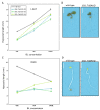The Turnera Style S-Locus Gene TsBAHD Possesses Brassinosteroid-Inactivating Activity When Expressed in Arabidopsis thaliana
- PMID: 33202834
- PMCID: PMC7697239
- DOI: 10.3390/plants9111566
The Turnera Style S-Locus Gene TsBAHD Possesses Brassinosteroid-Inactivating Activity When Expressed in Arabidopsis thaliana
Abstract
Heterostyly distinct hermaphroditic floral morphs enforce outbreeding. Morphs differ structurally, promote cross-pollination, and physiologically block self-fertilization. In Turnera the self-incompatibility (S)-locus controlling heterostyly possesses three genes specific to short-styled morph genomes. Only one gene, TsBAHD, is expressed in pistils and this has been hypothesized to possess brassinosteroid (BR)-inactivating activity. We tested this hypothesis using heterologous expression in Arabidopsis thaliana as a bioassay, thereby assessing growth phenotype, and the impacts on the expression of endogenous genes involved in BR homeostasis and seedling photomorphogenesis. Transgenic A. thaliana expressing TsBAHD displayed phenotypes typical of BR-deficient mutants, with phenotype severity dependent on TsBAHD expression level. BAS1, which encodes an enzyme involved in BR inactivation, was downregulated in TsBAHD-expressing lines. CPD and DWF, which encode enzymes involved in BR biosynthesis, were upregulated. Hypocotyl growth of TsBAHD dwarfs responded to application of brassinolide in light and dark in a manner typical of plants over-expressing genes encoding BR-inactivating activity. These results provide empirical support for the hypothesis that TsBAHD possesses BR-inactivating activity. Further this suggests that style length in Turnera is controlled by the same mechanism (BR inactivation) as that reported for Primula, but using a different class of enzyme. This reveals interesting convergent evolution in a biochemical mechanism to regulate floral form in heterostyly.
Keywords: BAHD acyltransferase; heterostyly.
Conflict of interest statement
The authors declare no conflict of interest.
Figures





References
-
- Bateson W., Gregory R.P. On the inheritance of heterostylism in Primula. Proc. R. Soc. Lond. Ser. B. 1905;76:581–586. doi: 10.1098/rspb.1905.0049. - DOI
-
- Barrett S.C.H., Cruzan M.B. Incompatibility in heterostylous plants. In: Williams E.G., editor. Genetic Control of Self-Incompatibility and Reproductive Development in Flowering Plants. Kluwer Academic Publishers; Dordrecht, The Netherlands: 1994. pp. 189–219. - DOI
-
- Darwin C. The Different Forms of Flowers on Plants of the Same Species. John Murray; London, UK: 1877.
-
- Mather K. The genetical architecture of heterostyly in Primula sinensis. Evolution. 1950;4:340–352. doi: 10.1111/j.1558-5646.1950.tb01404.x. - DOI
-
- Lewis D., Jones D.A. The genetics of heterostyly. In: Barrett S.C.H., editor. Evolution and Function of Heterostyly. Springer; Berlin, Germany: 1992. pp. 129–150. - DOI
Grants and funding
LinkOut - more resources
Full Text Sources
Other Literature Sources

